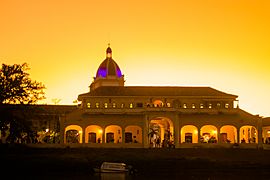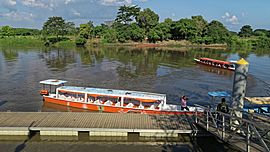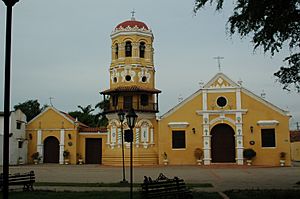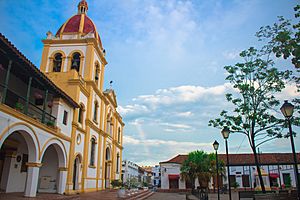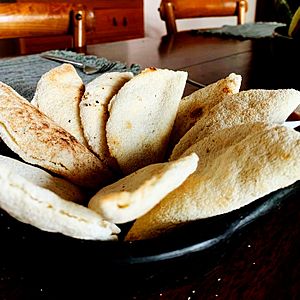Santa Cruz de Mompox facts for kids
Quick facts for kids
Santa Cruz de Mompox
|
|||
|---|---|---|---|
|
Municipality
|
|||
|
|||
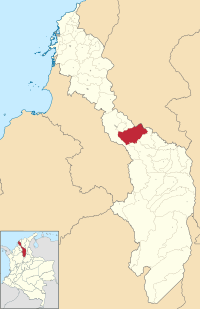
Municipality and town of Mompox in the Bolivar Department.
|
|||
| Country | |||
| Region | Caribbean Region | ||
| Department | Bolivar Department | ||
| Foundation | 3 May 1537 | ||
| Founded by | Alonso de Heredia | ||
| Area | |||
| • Municipality | 652.1 km2 (251.8 sq mi) | ||
| • Urban | 4.53 km2 (1.75 sq mi) | ||
| Elevation | 33 m (108 ft) | ||
| Population
(2020 est.)
|
|||
| • Municipality | 46,408 | ||
| • Density | 71.167/km2 (184.322/sq mi) | ||
| • Urban | 23,649 | ||
| • Urban density | 5,221/km2 (13,521/sq mi) | ||
| Time zone | UTC-5 (Colombia Standard Time) | ||
| Website | Official website: http://www.santacruzdemompos-bolivar.gov.co | ||
| UNESCO World Heritage Site | |||
| Official name | Historic Centre of Santa Cruz de Mompox | ||
| Criteria | Cultural: (iv)(v) | ||
| Inscription | 1995 (19th Session) | ||
Mompox (also spelled Mompós), officially called Santa Cruz de Mompox, is a historic town in northern Colombia. It is located in the Bolívar Department. The town grew because it was close to the Magdalena river. It has kept a lot of its old colonial look. Mompox was also very important in the fight for independence from Spain.
Today, Mompox relies on visitors, fishing, and some trade from raising cattle. The town is home to about 46,408 people. It is next to the towns of Pinillos and San Fernando. In 1995, the old part of Mompox became a UNESCO World Heritage Site. This was because of its well-preserved colonial buildings and mix of building styles.
Contents
History of Mompox
The name Mompox comes from "Mampo" (or "Mompoj"). He was the local leader of the Malibu people when the Spanish explorers arrived. So, Mompox means "land of the ruler Mampo." The town was started on May 3, 1537, by Alonso de Heredia. He was the brother of Pedro de Heredia. It was a safe port on the Magdalena River.
Santa Cruz de Mompox became very rich. It was a key port for moving goods upriver into the country. A royal mint was built here, and the town was famous for its goldsmiths. On August 6, 1810, Mompox was the first town in Colombia to declare its freedom from Spain. Their motto was "Be free or die" (Ser libres o morir). The flag of Mompox, which is red with a white cross, comes from this time in 1810.
Simon Bolivar first came to Mompox in 1812. He gathered 400 men to join his army. They fought in his Admirable Campaign. A monument called Piedra de Bolivar remembers his time in Mompox.
Mompox's importance as a river port began to fade in the early 1900s. This happened because too much dirt built up in the river. Boats started using a different path through Magangué instead.
In 1987, a movie called Chronicle of a Death Foretold was filmed partly in Mompox. It was based on a book by Gabriel García Márquez.
UNESCO named the historic center of Mompox a World Heritage Site in 1995. In 2010, the Colombian government named Mompox a Pueblo Patrimonio (heritage town). It was one of only 11 towns chosen for this special program.
Buildings and Architecture
Santa Cruz de Mompox is famous for keeping its old colonial buildings. They show a mix of Spanish and local styles. Many of these old buildings are still used for their original purpose today.
You will notice the beautiful ironwork on doors, railings, and window grills. This can be seen on streets like Calle de la Albarrada and Calle Real del Medio. Important churches include Santa Bárbara (built 1613), San Agustín (built 1606), San Juan de Dios, and Immaculate Conception. There is also a museum with amazing religious gold artworks from colonial times.
Historic Buildings
- San Juan de Dios Hospital was started in 1550. In 1663, a group called La Orden de todos los Hermanos Hospitalarios (The Knights Hospitaller) took over its management. It got money from rich families and a tax on river shipping. San Juan de Dios is thought to be the oldest hospital in America still working in its first building.
- City Hall used to have colonial jails and the mayor's office. On August 6, 1810, the document declaring independence from Spain was signed here. The cry "Ser Libres o Morir" ("Freedom or Death") was first heard in this building.
- The Municipal Palace, also known as the Cloister of San Carlos, was built in 1660. This building was the city's first high school until the Jesuits left. It stopped being a convent in 1767. In 1809, the Universal School of Saint Peter the Apostle was founded here.
- The Church of the Immaculate Conception was first built with mud bricks in 1541. Ten years later, it was made bigger with stone, and the straw roof was replaced with tiles. Because it was so large, it was often seen as Mompox's main church. The building was fixed many times, with the last major repair in 1795. In 1839, the current church was built on the same spot.
- The Santa Bárbara Church is one of the city's most famous churches. Finished in 1613, it has a special bell tower with a balcony. The tower is decorated with palm trees, flowers, and lions. The church's three altars are covered in gold.
- The Cemetery was built in 1829. The chapel and altar inside were added in 1846. Before this, people were often buried inside churches, which caused problems.
- The San Francisco Church was first built in 1564. The convent next to it was started in 1580.
- The House of the Apostles is on Calle Real del Medio. It was once a rich shipping family's home. Visitors come to see the images of the twelve apostles and Jesus at the Last Supper.
Tourism and Festivals
Mompox is a popular place for tourists. People love its history, colonial buildings, and fun festivals. Every year, the town hosts the Mompox Jazz Festival. It also has film festivals.
Many visitors come during Holy Week celebrations. These start on Palm Sunday with a parade of flowers and candles to honor the dead. Then there are other religious events. All these things make Mompox a popular spot for religious tourism in Colombia.
Local Food
Another great reason to visit Mompox is its food! You can find many dishes made with cassava, corn, fish, achiote, and chili pepper. A local street food is the casabito. It's like an omelet made with raw cassava, cheese, ground coconut, sugar, and sometimes anise.
Another famous treat is queso de capa. This cheese has been made for over 100 years. It has a stretchy texture and is served in layers.
Juice from the corozo berry is common here. It is also used to make wine.
Filigree Art
In the 1500s, several groups of skilled workers started in Mompox. These included people who worked with clay, blacksmiths, goldsmiths, and silversmiths. At the same time, Mompox was an important place for trading gold from Antioquia. This meant a lot of gold was left in town for local sales.
These two things helped the art of filigree spread.
The local goldsmiths used an old way of casting metal. They combined it with techniques brought by African slaves. This created Mompox filigree. This art uses very thin threads of metal. These threads are twisted together to make beautiful decorations, often with spiral shapes.
Because gold is very expensive now, artists have learned to use silver instead.
Getting to Mompox
- By Air: Mompox has its own airport, called San Bernardo de Mompóx airport.
- By Land: You can take a bus from Carmen de Bolívar. It travels on a road called Transversal de los Contenedores (now Ruta del Sol III). The bus will turn off at La Gloria, Magdalena, and pass through Santa Ana and Talaiga Nuevo. Then it will reach Mompox.
There is a huge bridge called the Reconciliación bridge. It is about 12 kilometers (7.4 miles) long and goes over the Magdalena river. It opened on March 30, 2020. This bridge connects the western and Magdalena Medio highways. These are part of the Ruta del Sol. The bridge helps people travel between the inner country and the Colombian Caribbean coast about 3 hours faster. It also helps the economy of Mompox and La Mojana.
The bridge project includes the Santa Lucia and Roncador bridges, the Isla Grande highway, and a road to connect the Roncador and Bodega bridges.
- By Water: The main way to get to Mompox by water is through the Mompóx branch of the Magdalena river. Mompox has a river terminal. It is connected to the old river port. Boats from Magangué, El Banco, Santa Ana, and Barrancabermeja can arrive here.
Famous People from Mompox
- Totó la Momposina (a famous singer)
- Candelario Obeso (a well-known writer)
See also
 In Spanish: Santa Cruz de Mompox para niños
In Spanish: Santa Cruz de Mompox para niños


